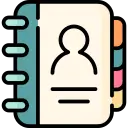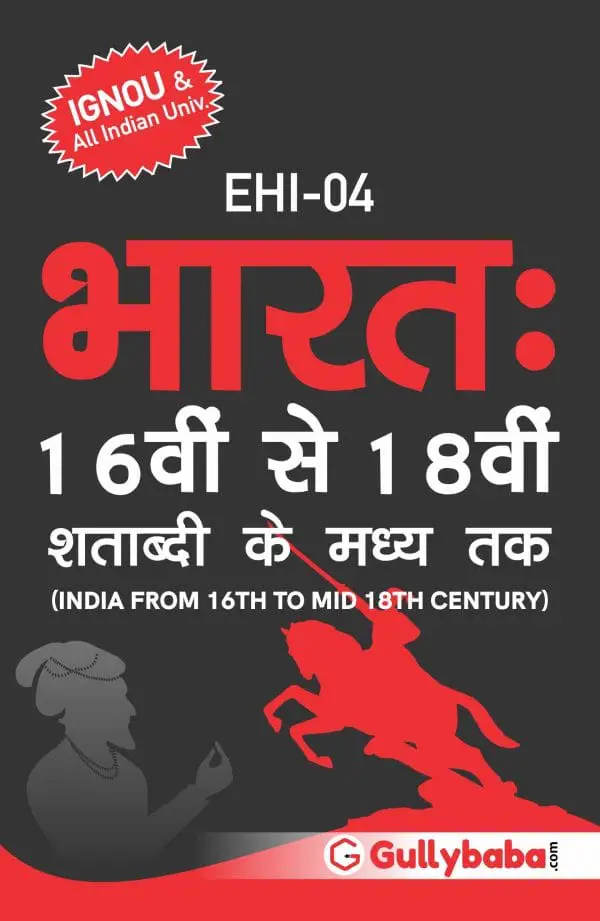EHI-04 English Topics Covered
Block 1 – India in the 16th Century
- Unit 1 – Political Formations in Central and West Asia
- Unit 2 – Polity and Economy in North India
- Unit 3 – Polity and Economy in Deccan and South India
- Unit 4 – The Trading World of Asia and the Coming of the Portuguese
Block 2 – Mughal Empire: Polity
- Unit 1 – Growth of Mughal Empire: 1526-1556
- Unit 2 – Expansion and Consolidation: 1556-1707
- Unit 3 – Relations with Central Asia and Persia
Block 3 – Regional Powers and the Mughals
- Unit 1 – Ahmednagar, Bijapur and Golkonda
- Unit 2 – The Deccan States and the Mughals
- Unit 3 – Rise of the Marathas in the 17th Century
- Unit 4 – Rajput States
Block 4 – Political Ideas and Institutions
- Unit 1 – Mughal Theory of Sovereignty
- Unit 2 – Mughal Ruling Class
- Unit 3 – Mughal Administration: Central, Provincial and Local
- Unit 4 – Mughal Administration: Mansab and Jagir
Block 5 – State and Economy
- Unit 1 – Mughal Land Revenue System
- Unit 2 – Agrarian Relations: Mughal India
- Unit 3 – Land Revenue System: Maratha, Deccan and South India
- Unit 4 – Agrarian Relations: Deccan and South India
- Unit 5 – Fiscal and Monetary System, Prices
Block 6 – Production and Trade
- Unit 1 – Agricultural Production
- Unit 2 – Non-Agricultural Production
- Unit 3 – Inland and Foreign Trade
- Unit 4 – Personnel of Trade and Commercial Practices
- Unit 5 – The European Trading Companies
Block 7 – Society and Culture-I
- Unit 1 – Population in Mughal India
- Unit 2 – Rural Classes and Life-style
- Unit 3 – Urbanisation, Urban Classes and Life-style
- Unit 4 – Religious Ideas and Movements
- Unit 5 – State and Religion
Block 8 – Society and Culture-II
- Unit 1 – Indian Languages and Literature
- Unit 2 – Science and Technology
- Unit 3 – Architecture
- Unit 4 – Painting and Fine Arts
Block 9 – India at the Mid 18th Century
- Unit 1 – Decline of the Mughal Empire
- Unit 2 – Rise of Regional Powers
- Unit 3 – Potentialities of Economic Growth: An Overview
EHI-04 Hindi Topics Covered
Block 1 – 16वीं शताब्दी में भारत
- Unit 1 – मध्य और पश्चिम एशिया में राजनीतिक संघटन
- Unit 2 – उत्तर भारत में राजनीति और अर्थव्यवस्था
- Unit 3 – दक्खन तथा दक्षिण भारत में राजनीति और अर्थव्यवस्था
- Unit 4 – एशिया की व्यापारिक गतिविधियाँ और पुर्तगालियों का आगमन
Block 2 – मुगल साम्राज्य: राजनैतिक संरचना
- Unit 1 – मुगल साम्राज्य का विकास: 1526-1556
- Unit 2 – विस्तार और सुदृढ़ीकरण: 1556-707
- Unit 3 – मध्य एशिया और इरान के साथ संबंध
Block 3 – क्षेत्रीय शक्तियाँ तथा मुगल
- Unit 1 – अहमदनगर, बीजापुर और गोलकुंडा
- Unit 2 – दक्खनी राज्य और मुगल
- Unit 3 – सत्रहवीं शताब्दी में मराठा राज्य का उदय
- Unit 4 – राजपूत राज्य
Block 4 – राजनैतिक विचार और संस्थाएं
- Unit 1 – मुगल संप्रभुता की संकल्पना
- Unit 2 – मुगल शासक वर्ग
- Unit 3 – मुगल प्रशासन: केंद्रीय, प्रांतीय और स्थानीय
- Unit 4 – मुगल प्रशासन: मनसब और जागीर
Block 5 – राज्य और अर्थव्यवस्था
- Unit 1 – मुगल भू-राजस्व व्यवस्था
- Unit 2 – कृषि संबंध: मुगलकालीन
- Unit 3 – भू-राजस्व व्यवस्था: मराठा, दक्खन और दक्षिण भारत
- Unit 4 – कृषि संबंध: दक्खन और दक्षिण भारत
- Unit 5 – वित्तीय और मौद्रिक प्रणाली, कीमतें
Block 6 – उत्पादन और व्यापार
- Unit 1 – कृषि उत्पादन
- Unit 2 – गैर-कृषि उत्पादन
- Unit 3 – आंतरिक और विदेशी व्यापार
- Unit 4 – व्यापार के कार्मिक, और वाणिज्यिक गतिविधियां
- Unit 5 – यूरोपीय व्यापारिक कम्पनियां
Block 7 – समाज और संस्कृति-I
- Unit 1 – मुगलकालीन भारत की जनसँख्या
- Unit 2 – ग्रामीण वर्ग तथा जीवन शैली
- Unit 3 – शहरीकरण, शहरी वर्ग तथा जीवन शैली
- Unit 4 – धार्मिक विचार और आंदोलन
- Unit 5 – राज्य और धर्म
Block 8 – समाज और संस्कृति-II
- Unit 1 – भारतीय भाषाएँ और साहित्य
- Unit 2 – विज्ञानं और तकनीकी
- Unit 3 – स्थापत्य
- Unit 4 – चित्रकला और ललित कलाएँ
Block 9 – 18वीं शताब्दी के मध्य का भारत
- Unit 1 – मुगल साम्राज्य का पतन
- Unit 2 – क्षेत्रीय शक्तियों का उदय
- Unit 3 – आर्थिक विकास की संभावनाएँ: अवलोकन













